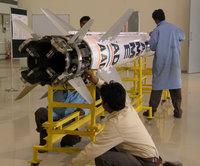NEW DELHI -- Two weeks ago, a ballistic missile blasted off from a warship sailing in the Bay of Bengal. Its target was Wheeler Island, a small enclave of land off the coast of India and home to one of India's most important missile testing facilities. Within seconds of the launch, the Indian military's radars and computer banks began tracking the supersonic rocket. Several computations later, an alarm triggered another "hot" missile on the island that, once launched, began pursuing the aggressor warhead. Some 70 kilometers above the earth's surface, the two collided. The rocket's debris fell through the sky, most of it burned and vaporized. What little remained scattered like ash into the vast expanses of the Indian Ocean, marking India's third successful test of its nascent missile defense system. Over the past few years, the Defense Research and Development Organization (DRDO), the Indian military's scientific arm, has been trying to push India into a very exclusive club: countries that can boast of having a missile defense shield. The only other members so far are the United States, Russia and Israel. The recent success may not have generated the same level of national jubilation as the nuclear tests in 1998, but among strategic circles the satisfaction was clear. "The third consecutive interception of ballistic missile demonstrated the robustness of the Indian BMD system," remarked an overjoyed V. K. Saraswat, program director for India's Air Defense.
Indian Missile Defense: Success Too Soon?

